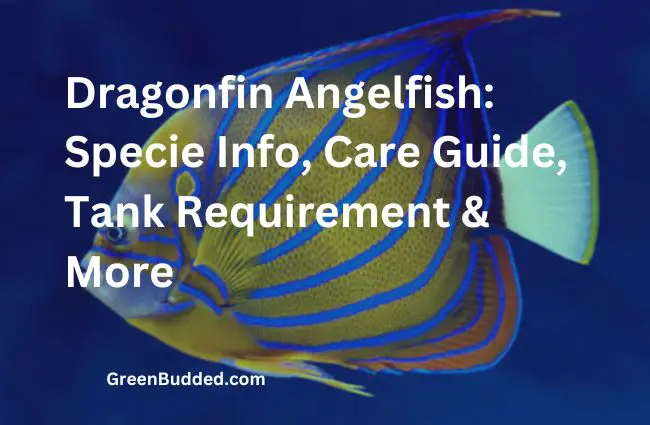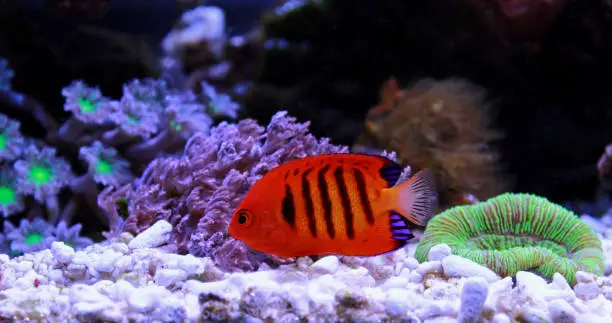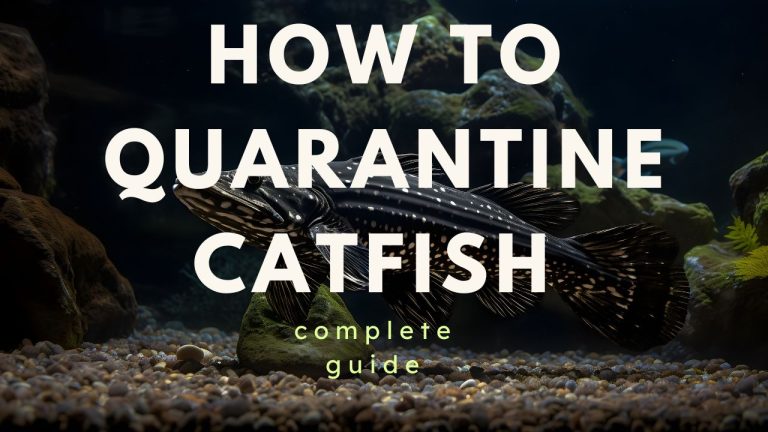Helpful Guides on each Category
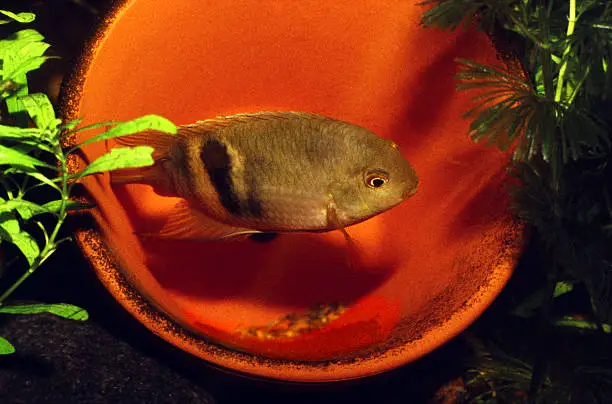
The keyhole cichlid (Cleithracara maronii) is a freshwater fish native to South America. This peaceful species is easy to care for and is a pet favourite for hobbyists, especially beginners.
Keyhole Cichlid Species Profile & Overview
| Scientific name: | Cleithracara maronii |
| Family: | Cichlidae |
| Origin: | South America |
| Size: | 4-5 inches (10-13 cm) long |
| Lifespan: | 8 – 10 years |
| Temperament: | Peaceful and non-aggressive |
| Tank needs: | 20 gallons minimum with hiding spots |
| Water pH: | 6.5 – 7.5 |
| Water Temperature: | 75-82°F (24-28°C) |
| Lighting: | Moderate |
| Diet: | Omnivore |
The keyhole cichlid hails from the tropical waters of South America. They inhabit the slow-moving, densely vegetated rivers and tributaries of the lower Orinoco Basin in Venezuela and the Guianas.
These calm waters with plenty of hiding spots are the keyhole cichlid’s natural haven.
Physical appearance
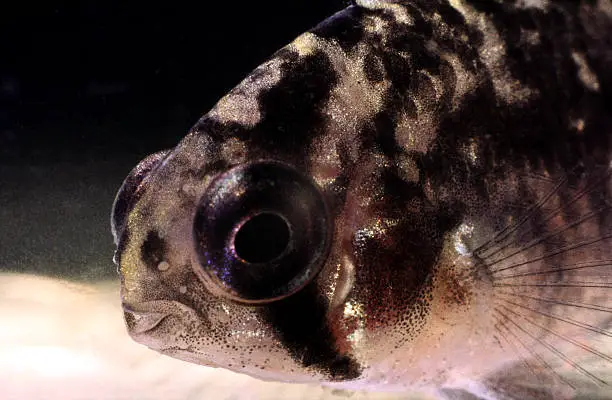
The keyhole cichlid lives up to its name with a striking black spot on its upper body. This spot often extends into a short, vertical stripe, resembling a keyhole – hence the name! Their overall body shape is oval and typically tan-coloured.
When stressed or startled, their body takes on a blotchy pattern, and they flatten themselves against rocks or logs to blend in with their surroundings.
size
How big do keyhole cichlids get? The keyhole cichlid is a relatively small fish, reaching a maximum size of around 4-5 inches (10-13 cm) in length. This makes them well-suited for aquariums of moderate size.
Lifespan
With proper care, keyhole cichlids can live for up to 10 years in an aquarium environment. This makes them a long-term commitment, so be sure you’re prepared to provide them with a happy and healthy home for the period.
Keyhole Cichlid Care
Tank size
- Single Keyhole Cichlid: A minimum of 20 gallons (75 litres) is recommended.
- Community Tank: For a community tank with other peaceful fish, aim for a minimum of 30 gallons (113 litres) or more, depending on the tankmates you choose.
Water parameters
Keyhole cichlid prefers slightly acidic to slightly alkaline water conditions. Here are the ideal parameters to maintain:
- Temperature: 75-82°F (24-28°C)
- pH: 6.5 – 7.5
- Water Hardness: 5-12 dGH (dH stands for degrees of general hardness, a measure of dissolved minerals in the water)
Regular water changes are crucial for maintaining good water quality. Aim for weekly water changes of around 25-30% of the tank volume.
Substrate
Keyhole cichlids are bottom dwellers who like to sift through the substrate for food. Choose a soft substrate that won’t damage their delicate fins. Here are some good options:
- Fine-grained sand
- Sand mixed with gravel
Avoid sharp-edged gravel or rocks that could injure your fish. You can also add a layer of leaf litter to the substrate, to simulate their natural habitat and provide additional food for them to nibble on.
Decoration
- Live plants: Live plants not only provide hiding places but also help improve water quality. Choose plants that can thrive in the slightly acidic to slightly alkaline water conditions keyhole cichlids prefer.
- Driftwood: Driftwood adds a natural aesthetic to your tank and provides additional hiding spots and grazing surfaces for your keyhole cichlids.
- Rocks and Caves: Rocks and caves can also create excellent hiding spots for your fish. Make sure any rocks or caves you choose are smooth and won’t trap or injure your fish.
Filtration
They need moderate flow, as they are not strong swimmers. A canister filter is a good option for keyhole cichlids as it provides excellent water quality and doesn’t create a strong current.
However, a hang-on-back filter can also work well as long as it’s rated for your tank size and doesn’t create too much flow.
Lighting
Keyhole cichlid is not demanding when it comes to lighting. They thrive in moderate lighting conditions to replicate shady South American waters.
The key is to avoid very bright lighting, which can stress out your fish. Aim for a moderate light cycle of around 8-10 hours per day.
Aquarium Plants
- Java Fern (Microsorum pteropus)
- Anubias spp.
- Amazon Sword (Echinodorus spp.)
- Water Sprite (Ceratopteris thalictroides)
keyhole Cichlid Tank Mates
So What can live with keyhole cichlids? These include
- Tetras
- Corydoras Catfish
- Angelfish
- Hatchetfish
What do keyhole Cichlids eat? Diet and Feeding
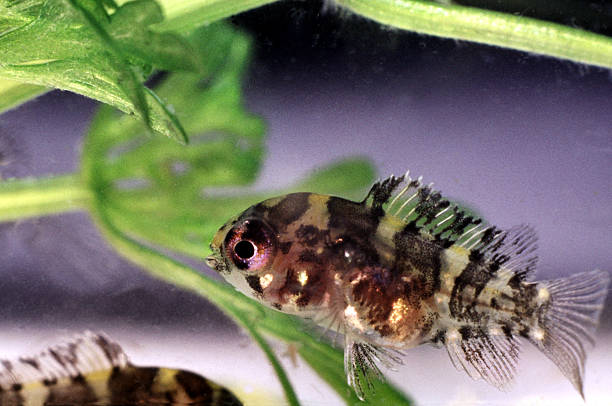
Keyhole cichlids are omnivores. Here’s what to include in your keyhole cichlid’s menu:
- High-Quality Flake Food or Pellets
- frozen or live bloodworms
- brine shrimp
- Daphnia
- Mysis shrimp
- Blanched spinach
- Zucchini
- algae wafers
Feeding frequency (2-3 times a day, small amounts).
Breeding
Keyhole cichlids are monogamous and form a breeding pair. Observe their behaviour for signs of pairing, such as chasing off other fish and spending time together cleaning a chosen flat surface like a rock or piece of slate.
The female lays hundreds of eggs on the chosen surface, and the male fertilizes them.
Both parents then guard the eggs and fry fiercely, fanning them with their fins to keep them oxygenated and removing any unfertilized eggs. This is mostly the only period they are aggressive.
Raising the Fry
- Hatching: The eggs will hatch in 3-5 days.
- Feeding Fry: The fry will be free-swimming within a few days and should be fed infusoria or newly hatched brine shrimp ( nauplii).
Once the fry is free-swimming, you can separate them from the parents to prevent them from being eaten.
What is the Behaviour of a keyhole cichlid?
The keyhole cichlid’s temperament is one of its biggest draws for aquarists. They are known for being Peaceful, Shy and Social (with limitations).
As they mature, they become a bit territorial, particularly when breeding. However, this territorial behaviour is usually manageable in a spacious tank with enough hiding places.
Here are some additional interesting behaviours to note:
- Browsing: Keyhole cichlids are omnivores and spend a good portion of their time sifting through the substrate for food scraps and detritus.
- Breeding: Keyhole cichlids are bi-parental substrate spawners. This means both parents work together to care for their eggs and fry.
- Stress Response: When stressed, keyhole cichlids can change their colouration to a darker shade and display a blotchy pattern. They may also become more reclusive and hide more frequently.
How many keyhole cichlids should be kept together?
A group of 6 keyhole cichlids can be kept together in a tank. This number is also a good option for a peaceful community tank with other compatible fish species.


